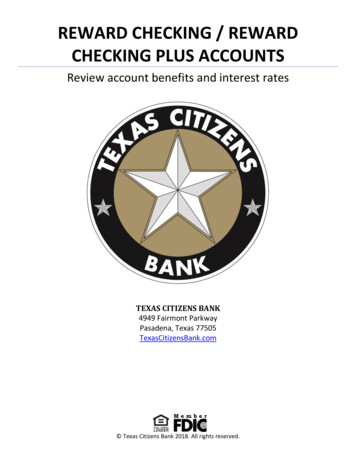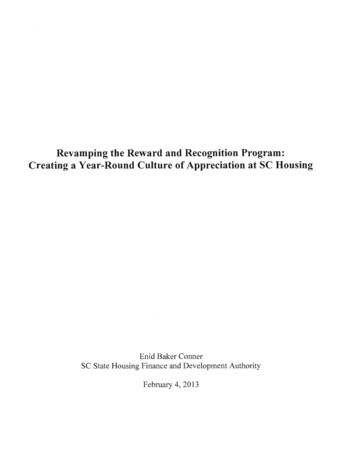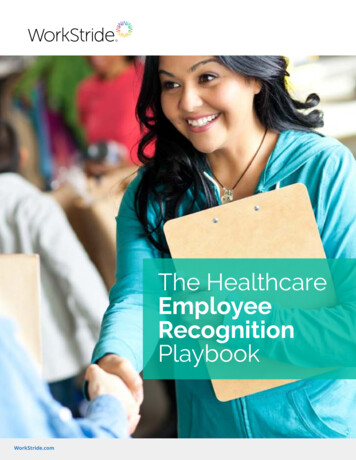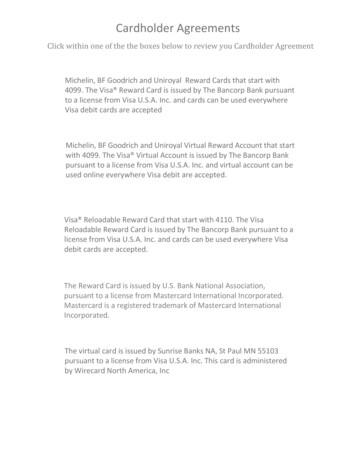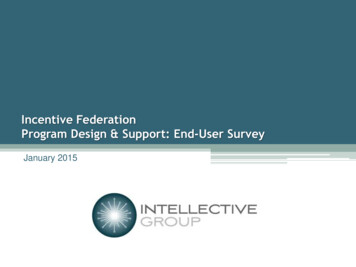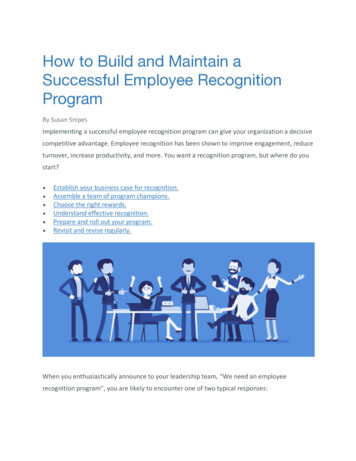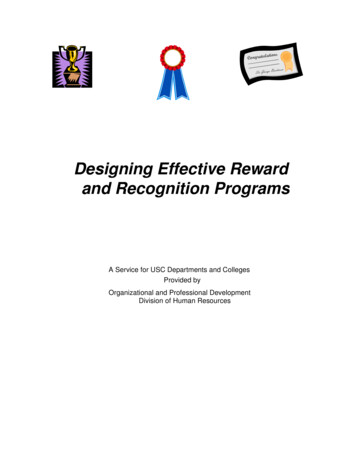
Transcription
Designing Effective Rewardand Recognition ProgramsA Service for USC Departments and CollegesProvided byOrganizational and Professional DevelopmentDivision of Human Resources
IntroductionA reward is considered to be something that is given in return for good behavior or givenfor some service or attainment. It can also be considered as a stimulus administeredfollowing a correct or desired response that encourages the reoccurrence of the response.Recognition is considered acknowledgement or a special notice or attention.In an organization, reward and recognition programs must affect behavior measurably,improve results and deliver both tangible and intangible awards that everyone can earnand that everyone enjoys. To that end:1. People should feel good about what they receive; and2. The organization should benefit from a more positive workforce.To do that a process must have the following key features:A.B.C.D.A variety of recipients;A mixture of formal and informal recognition;Timeliness; andAbundanceIn addition, the organization must be able to get a Return on Reward (ROR) if they are tosustain any initiative. Similarly, the people in the organization must know where theystand at all times compared to the standards through feedback.The goal for both can be summed up in the following equation:Right RewardsRight PeopleRight Reasons Right ResultsA good reward and recognition system is a “pulling” strategy. It pulls people into itbecause they see what is being rewarded and recognized, it feels good to be part of boththe receiving (and hopefully the giving) of the rewards and recognition, and they want tobe part of it. However, research indicates that behaviors take about 20 tries before theyare assimilated in a person’s normal patterns. In other words, to fully integrate peopleinto this type of culture, both patience and consistency are required of the organization.Page 2Rev 4/2014
Process for Establishing a Recognition SystemStep 1Step 2Establishing thefoundation for theorganizationSelecting aRecognitionChampionStep 4Designing theprocessStep 7Planning forinfrastructuresupportStep 5Piloting/Introducingthe processStep 8Evaluating andimproving theprocessStep 3Developing therequirements for theprocessStep 6Preparing therolloutStep 9Providing forongoingsupport of theprocessThe goal of any reward and recognition system is breadth. Reward and recognitionsystems must affect behavior measurably, improve results and deliver both tangibleand intangible awards that everyone can earn and that everyone enjoys.Page 3Rev 4/2014
Pre-WorkIs your organization ready to implement a reward and recognition process?This seems like an easy question, but it can only be answered following an assessment ofthe organization’s current patterns of recognition. The goals of the assessment processare as follows:1. Gain some awareness of the agency’s attitudes about reward andrecognition;2. Measure current reward and recognition patterns;3. Determine the gap between current and desired patterns; and4. Identify the personal recognition patterns of agency leaders.Here are some of the questions that should be asked or observations made:1.2.3.4.5.6.7.8.Does the agency have visible proof of recognition in the work areas?Do people have congratulatory parties or other spontaneous events?Are there mementos visible of recognition?Can people tell you “stories” about receiving, giving or observing recognition?Is there evidence that the current process is owned by everyone?Are people evaluated in part on the amount of recognition they give?Are there tools and vehicles in place that allow people to reward others?Where would the agency rate itself on the following scale?Our CurrentStatus (Checkone)RatingScale10987654321Page 4Descriptions of Behaviors Related to RecognitionWe live recognition – it is embedded in our culture. Everyone freelyrecognizes each other through a myriad of recognition vehicles that are inplace within the organization.We acknowledge the importance of recognition in our organization’sphilosophy. There is an organization-driven recognition program in place.In addition, some of us do the spontaneous peer-to-peer things.We are average – there is formal, agency-driven recognition program(s) inplace and most people are comfortable with it.We do a little – the agency head gives some awards each year to recognizewhat we’ve done. A few top performers are identified.Recognition? No need to recognize anyone- a true professional knows hisown worth and doesn’t need that type of thing.Rev 4/2014
Additional information that you may want to gather would include responses to thefollowing questions from selected senior managers: How free are people to comment on one another’s behavior and contributions?Would you consider your feedback process to be a plus in your organizationalculture?Are you pleased with your agency’s current situation?Do your agency’s communication patterns encourage recognition?If you could make changes to improve communication, and thus recognition, whatwould these be?Step One – Establishing the FoundationOnce commitment to a reward and recognition process has been established, and thecurrent patterns have been assessed, the organization can move on to determining howsuch a process can be implemented.GoalsThe goals of this step in the process are:1. To determine the focus of the process;2. To identify the various facets of the process; and3. To identify how the process will be measured to determine success.These must be done by senior management or representatives from this group.Questions to be Asked1.2.3.4.5.6.7.8.Will the process be management driven?Will it focus on a team-based or peer-to-peer process?Will there be some effort to include multiple types of recognition?How will the different facets be introduced, in what order, and how will theycomplement one another?What measures will be in place to let us know they are successful?What are the core recognition drivers (values) for your organization or team?Who will be the primary target audience for controlling, giving and receivingrecognition?What mechanisms will the agency use for rewards?Potential Problems Process too management drivenNot enough clarity in values for agencyUnclear audienceView of recognition as solely a management prerogativePage 5Rev 4/2014
Step Two – Selecting a ChampionAfter the foundations have been established, the organization must choose a champion toensure that the process will have the requisite support at the highest levels of theorganization. A champion owns the process and exemplifies the recognition-basedbehavior that the agency wants. The champion is there to make sure the support piecesare available and minimizes obstacles.This also must be done by senior management.GoalTo find someone that can effectively lead the process and who is willing to do so.Questions to be AskedTo identify the person(s) who could be candidates within the agency:1. Who are the person(s) with good recognition patterns in the agency?2. Who is in a role to influence the agency? How does their position enhancetheir ability to champion the process?3. What are some of the characteristics you would like to see in a person whoplays the champion role?4. How would you sell the idea to a potential champion?5. What type of support are you prepared to offer this person?6. What specifically will you require of your champion?7. If this person turns out to be inactive or otherwise inappropriate, how will youtake action to replace that person?Potential Problems Cannot find a good role model high in the organizationBest candidate(s) are unwillingLack of specificity as to responsibilities of championVague support or direction given to championPage 6Rev 4/2014
Step 3 – Developing the Parameters of the ProcessAt this stage, the high level parameters for the recognition must be set by seniormanagement. This can probably best be done in a planning retreat setting.GoalTo determine what is important to management in the way of reward and recognition andensure that the process developed will also match employee needs and expectations.Questions that Should be Asked1. What is the agency dollar commitment to the process?2. Is there consensus agreement to support actively whatever process isimplemented?3. What types of recognition are to be put in place (management-driven, peer-topeer, team-based)?4. Will there be public ceremonies?5. Will there be a combination of monetary and non-monetary rewards?6. Who will participate in the giving?7. How will the finances of the process work?8. How will the agency ensure that the awards are given in a timely manner?9. Will managers be evaluated on their use of the process?10. When will the process begin (a target date)?11. How will the design team be chosen?Potential Problems Senior management trying to micro-manage the process (dealing with too manyprogram specifics)Leaving some decisions “open” at this pointNot putting the parameters in writingUnrealistic target datesNot enough financial commitmentLack of consensus on the process by upper managementLack of breadth in the designPage 7Rev 4/2014
Step 4 – Designing the ProcessAfter senior management has developed the macro-level parameters, a design teamshould be assembled to design the specifics of the process. The organizational championshould either chair the design team or have active oversight of it.GoalsTo determine the following:1. Decide what the process should look like;2. Determine what needs to be included in the process; and3. Detail how provisions for the desired reward and recognition are to be providedand accessed.Questions that Should be Asked1.2.3.4.5.6.7.8.Who will be on the design team?How can we ensure the best people are chosen?How will the design team get employee input into the process?What will be the scope of the design process?What boundaries have been, or need to be, set?What support will be provided for the team?Exactly how will the mechanics of the program be administered?How will the program be evaluated and measured?Potential Problems Inadequate representation on the teamInappropriate people on the teamPoor choices made regarding how to get employee input into the processLow response to employee input requestsUnclear boundaries for the processLack of administrative or other supportFuzzy details on implementationPoor measures createdPage 8Rev 4/2014
Step 5 – Piloting/Introducing the ProcessIdeally, an agency would do a true pilot program (a division or unit first) or phase in theprocess selected. This allows for design modifications prior to rollout to the entireorganization.GoalTo allow time for people to understand, test and evaluate the designed process and learnwhat works and what does not work.Questions that Should be Asked1. Which process (pilot, phase-in, total implementation) will work best for theagency?2. Is the agency prepared to provide an overview of what you intend to do and howit will be managed?3. How long should a pilot last?4. How will a pilot be evaluated?5. Where will it be piloted? Why there?6. What will be phased in first?7. Are the administrative responsibilities clear?Potential Problems Unclear evaluation processDetails insufficient to implement a pilotInadequate time allotted for evaluationPoor choice of pilot locationUnclear responsibilities for implementationPage 9Rev 4/2014
Step 6 – Preparing for RolloutManagers and employees need to be educated on how the program will work and the newway of thinking that is required to create an effective reward and recognition culture. Astrategy outlining the education process must be created.GoalTo ensure that everyone hears the same message about the recognition process and toorient managers and employees in the new culture that the process is designed to helpcreate.Questions that Should be Asked1.2.3.4.5.What is the communication plan to employees and managers?Will the plan have multiple mechanisms to ensure coverage and understanding?Will there be training offered? To whom?Who will do the training?What content is appropriate for the agency?Options to ConsiderA.B.C.D.E.F.G.H.I.All employee memos or e-mailsAll employee meeting(s) to describe the programNewsletter articlesManagers introducing the process at unit meetings using provided scriptsincluding:a. Why use the process-tied to agency vision and philosophyb. Roles of managers and employeesc. Details on what can be given, how it can be given, who does the giving,when it is done, where it is done and why it is doned. Goals of the process and how it will be monitored and evaluatedSelecting a set of “messengers” to present a common message throughout theagencyMaking recognition a regular feature in meetings and in formal communicationsA celebration rally to kick it offPutting up posters or banners to kick it offTraining of employees and managers if using peer-to-peer or team-basedprogramsPotential Problems Inadequate communication during rolloutPoor recognition skills of managers and employees, not addressed by trainingInsufficient “positive” message given to create interestPage 10Rev 4/2014
Step 7 – Planning for Infrastructure SupportThe planning process must account for the allocation of resources and budget to therecognition. Additionally, an administrative process must be established.GoalTo establish what is going to be done, by whom, when, how and at what cost.Questions that Should be Asked1. How will the materials and supplies for the process be made available?2. Who will be responsible for coordinating the purchase and maintenance of thematerials and supplies?3. How will the agency acknowledge those who give recognition?4. In what format will the information and materials be available to managers andemployees?5. What human resources will be available to employees and managers?Potential Problems Inadequate materials or spotty distributionInconvenient mechanisms used to distribute supplies and materialsNo positive acknowledgement of recognition giversLack of help when needed for employees and managersPage 11Rev 4/2014
Step 8 - Evaluating and Planning for Process ImprovementSince people and conditions change, an agency must develop an evaluation mechanismfor the process. A good evaluation process will help the agency measure Return onReward (ROR). It also provides an opportunity for potential changes to be identified andimplemented. Measures should have been identified in the design phase (step 4), so thisstage relates to analysis and evaluation of the data.GoalImplement a robust evaluation system that has meaningful measures and provides amechanism to recommend changes to the process.Questions that Should be Asked1.2.3.4.5.6.7.What does the monitoring data collected indicate about the health of the program?Are the mechanisms used to collect the data adequate?Do informal measures validate more formal measures?Is the analysis conducted sufficient to evaluate the process?How will we share the evaluation results with employees and managers?Does the data indicate the need to change anything in the process?Does the data show any trends that need to be investigated further?Potential Problems Poorly designed measuresData collection faultyInsufficient analysis of dataContradictory measuresNo sharing of resultsUnclear meaning of data gatheredPage 12Rev 4/2014
Step 9 – Providing Ongoing SupportKeeping the process fresh and meaningful for employees is a challenge. Maintenance ofprocesses needs to be done in advance because even good programs suffer from inertia.The process needs to be fun and inviting.GoalTo create an approach that will facilitate reminding people about using the process and toprevent people from backsliding into old habits.Questions that Should be Asked1.2.3.4.5.6.How will the employees be reminded about the program?How will the process be talked about on a regular basis?What incentives will there be for people to be involved?How will good role models be celebrated?What sort of ongoing publicity will the program receive?Who will be responsible for maintenance?Potential Problems No reminders planned, or irregular remindersNo ongoing communication strategyNo incentives for people to be involvedRole models not celebratedInadequate publicityNo one responsible for maintenancePage 13Rev 4/2014
Reward and Recognition as an Organizationaland Professional Development (OPD) ServiceWe provide a three-tiered approach. These approaches vary according to the amount ofdirect OPD involvement and facilitation assistance the agency receives.Three Possible ApproachesServices IncludeFacilitate a management meeting to set goals for theprocessProvide a full assessment of current culture andpractices related to reward and recognitionFacilitate a management retreat to discuss programfoundations, select a champion and create processparametersFacilitate the design team in the creation of theprocess (steps 4, 7, and 9 included)Monitor pilot processProvide management/employee training(prior to rollout)Evaluate the program (6-12 months later)Provide resource materials for agency implementationHuman Resources staff available for questionsFully GuidedxPartiallyGuidedxResourcexxxxxxxxxxxxxxxxFor agencies interested in collaboration, OPD will develop a memorandum of agreementwith the agency to specify the nature of the relationship, the type of service chosen andthe responsibilities of each party.Page 14Rev 4/2014
Recognition is considered acknowledgement or a special notice or attention. In an organization, reward and recognition programs must affect behavior measurably, improve results and deliver both tangible and intangible awards that everyone can earn and that everyone enjoys. To that end: 1. People should feel good about what they receive; and 2.
